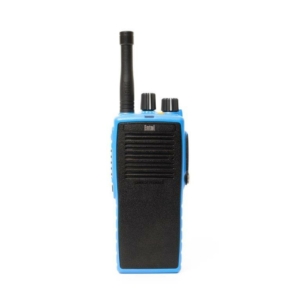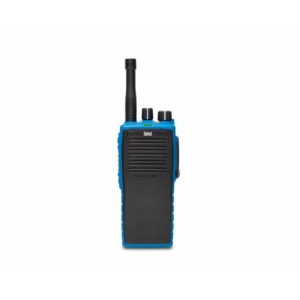The term "ATEX transceiver" refers to the ATEX Directive, which stands for "Atmosphères Explosibles". The ATEX Directive defines the standards and specifications adopted by the European Union for equipment that operates in potentially explosive atmospheres.

ATEX certified transceivers comply with the ATEX directives and are capable of receiving and/or transmitting radio waves in potentially explosive atmospheres. These devices are often used in industrial environments where the presence of gases, vapours or dusts can create an explosion hazard. The ATEX directives contain strict requirements for the design, manufacture and use of this type of equipment in order to minimise the risk of explosion.
This is why it is important that you do your research before purchasing an ATEX transmitter and check that the device complies with the directives and the necessary safety requirements. This usually requires an expert who can assess the risk of explosive atmospheres and environments. Depending on this, determine which ATEX levels (intrinsically safe classification) the equipment must have in order to be used in the environment.
Once you have the ATEX rating recommended by an expert, it's easier to choose your equipment!
What do the ATEX markings and classifications on the transceivers mean?
All ATEX equipment must bear the CE marking followed by the notified body's serial number. The CE marking is a European standardisation marking and indicates that the product complies with the health, safety and environmental requirements set by the EU. The Ex logo is displayed on the equipment, followed by a series of codes that define the approval classification. An example of a hazardous area engine is shown below:

The ATEX marking consists of five elements:
- Equipment group code and safety category
- Air circuit
- Type of protection
- Gas group
- Temperature class
What is the equipment group and safety category?
There are two main equipment groups (indicated by Roman numerals) and these are divided into safety categories:
|
Equipment group |
Safety category |
||
| I |
The equipment is suitable for use in underground parts of mines and in parts of surface installations where there is a risk of firedamp and/or combustible dust. |
M1 |
The equipment can be used in mines and can be operated safely in explosive atmospheres. |
| M2 |
The equipment can be used in mines, but only if there is no explosive atmosphere. If this is not the case, the equipment must be de-energised. |
||
| II |
The equipment is suitable for all non-mining applications. |
1 |
The level of protection is very high and the equipment is safe to use if an explosive atmosphere is present continuously or for long periods. |
| 2 |
The level of protection is high and the equipment is safe to use if explosive conditions occasionally occur under normal operating conditions. |
||
| 3 |
|
||
If a transmitter is designed to be used in more than one environment, each zone may have an Ex code.
What is the protection code?
To eliminate the risk of electrical sparks, any equipment containing a circuit may include additional features such as a sealed enclosure. These features are indicated in the Ex marking by one or more lower case letters. Some examples of transceivers and complementary systems are shown in the table below:
| Symbol |
|
|
| d |
|
|
| db |
Flame retardant, Category 2, Zone 1 suitable for area use. |
|
| eb |
|
|
| ec |
|
|
| ia |
|
|
| ib |
|
|
| ic |
|
the circuit is low power and cannot transfer enough energy to ignite the explosive atmosphere. This is the only type of protection permitted in Zone 0/20 environments.
What is a gas group?
The chemical properties of the explosive atmosphere - such as molecular weight, upper and lower explosive limits and flame temperature - affect the likelihood and severity of an explosion. Testing of these properties has led to the definition of design parameters, including the Maximum Experimental Safety Gap (MESG), which is used to classify flammable gases when designing electrical equipment in hazardous areas.
The MESG measures the ease with which a gas flame can penetrate through a narrow gap bounded by a heat-absorbing metal. Each material has its own combination of properties, but their MESG values fall within a similar range, simplifying the selection of equipment for hazardous areas.
All chemical gases or vapours used in industry can be grouped into one gas group.
| Gas Group | Typical materials |
| IIC | Acetylene and hydrogen |
| IIB | Ethylene |
| IIA | Propane |
What is the ignition source?
The explosive atmosphere must be protected from ignition sources. Examples of ignition sources are friction sparks and high surface temperatures. Aluminium components can cause the formation of friction sparks, so it is important that clutch protective covers are not made of this and preferably of other sparking metals. It is also important that the equipment does not exceed the auto-ignition temperature of the atmospher.
What is the temperature class?
The Ex designation is a code that indicates the maximum possible surface temperature of the equipment. In some cases, the maximum surface temperature is explicitly stated. An ATEX specification may also include an ambient temperature range for "safe" operation, e.g. +1°C < Ta <40°C. Where this is not stated, it is assumed to be between -20°C and +40°C.
| ATEX temperature code | Maximum surface temperature °C |
| T1 | 450 °C |
| T2 | 300 °C |
|
T3 |
200 °C |
| T4 | 135 °C |
| T5 | 100 °C |
| T6 | 85 °C |
Now that we know the meaning of ATEX signs, let's look at an example of a transceiver.
It is important to note that there can be differences even within one type!
Hytera HP795 ATEX IIA and HP795 IIC are similar types, but still 2 different markings.
What do IIA and IIC mean?
The difference between the two ATEX models is the ATEX gas group, the temperature range for use in explosive atmospheres and the RF transmission power.
- low ATEX IIA gas group (e.g. propane), high Tx power 4W/1W
- high ATEX IIC gas group (e.g. acetylene, hydrogen), Tx power 2W/1W
The different RF transmitter power is a consequence of the ATEX level. IIC can be used for more hazardous gases with a lower flash point (e.g. hydrogen is more flammable than propane).
Here you can find the intrinsically safe ATEX classifications:
IIC model version
- Mining: I M2 Ex ib I Mb
- Gas: II 2G Ex ib IIC T4 Gb
- Dust: II 2D Ex ib IIIC T120°C
- Db/Tamb = -25°C to +60°C/IP66 IP67 IP68;
IIA model version
- Mining: I M2 Ex ib I Mb
- Gas: II 2G Ex ib IIA T4 Gb
- Dust: II 2D Ex ib IIIC T120°C
- Db/Tamb = -25°C to +50°C/IP66 IP67 IP68;
Now we know the difference between the two markings, but even then, let a professional choose the right ATEX radio for the job site!
Important!
If you are about to buy an ATEX transceiver, always consult the designated specialist at the work site or factory! We at Anico Ltd. can only recommend a suitable transceiver, if we receive full information about working conditions. In this case, feel free to contact our technical colleagues by phone or e-mail.










